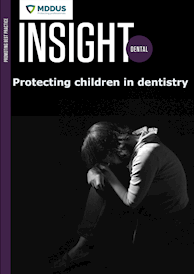BACKGROUND
Mrs T is a 52-year-old heavy smoker. She makes an emergency appointment at her dental surgery complaining of severe pain and swelling in her lower left jaw. Dr O notes that LL6 is tender to percussion and mobile. A radiograph reveals an area of extensive pathology and Dr O discusses treatment options with the patient.
Mrs T opts to have the tooth extracted and this is undertaken later the next day.
The procedure is “difficult” but Dr O extracts the tooth with roots intact. Postoperative instructions are provided to Mrs T and she is told to return if there are any problems.
Five days later Mrs T is back at the surgery complaining of severe pain from the socket and numbing in her lip and chin. Dr O notes an infected dry socket with buccal swelling causing paraesthesia due to nerve pressure. He irrigates and dresses the socket and prescribes amoxicillin.
Mrs T returns to the surgery a week later complaining of pain, numbing and an offensive smell. She sees a different dentist and the socket is irrigated and the dressing changed.
A review appointment is arranged for a week’s time. This time Dr O notes that symptoms are improving although the patient still has some paraesthesia. He advises Mrs T to monitor the situation and return if there is no further improvement.
Just over two weeks later Mrs T returns to the surgery and although the pain has eased the socket is still not healing as expected and the paraesthesia persists. Dr O prescribes another course of antibiotics and makes an urgent referral to the dental hospital.
Mrs T is seen two weeks later by an oral and maxillofacial surgeon. He notes that the socket is still non-healing with areas of necrotic bone and ulcerated gingiva. An OPG radiograph shows no bony infill and irregularities around the base of the socket. Blood tests, urgent debridement and a biopsy of the area are arranged. Histology reveals osteomyelitis.
Mrs T is prescribed clindamycin and further debridement is arranged. Review two months later with an OPG radiograph reveals the socket is healing well.
A solicitor’s letter is received by Dr O alleging clinical negligence in the care provided to Mrs T. It is claimed that Dr O should have referred Mrs T to an oral surgeon when she twice reattended the practice complaining of paraesthesia. It is further alleged that the delayed referral resulted in Mrs T having to undergo two debridement procedures. She also suffered ongoing left-sided jaw pain with difficulty eating for several months.
ANALYSIS/OUTCOME
An MDDUS dental adviser reviews the case along with a lawyer. An expert opinion is obtained from a consultant oral and maxillofacial surgeon.
The expert comments that although Mrs T was experiencing problems it would be a reasonable assumption from the clinical examination that this was due to a dry socket. Paraesthesia after a week would not normally be present but there could be a number of possible causes and not a definite indication of osteomyelitis.
The expert further observes that dental records from the subsequent appointment indicate that Mrs T’s symptoms appeared to improve, suggesting the infection was beginning to resolve. Therefore a referral would not have been necessary and such a conclusion would be supported by a reasonable body of dental practitioners.
The expert also opines that had Mrs T been referred earlier (on the balance of probabilities) she would have been managed in a similar fashion and would not have avoided the two debridement procedures.
A letter of response is drafted on behalf of Dr O denying liability and the case is subsequently discontinued.
KEY POINTS
- Clear and comprehensive clinical records are essential in defending against negligence claims.
- A clinician cannot be held liable if providing care that conforms to a standard reasonably expected of a competent practitioner.
This page was correct at the time of publication. Any guidance is intended as general guidance for members only. If you are a member and need specific advice relating to your own circumstances, please contact one of our advisers.
Read more from this issue of Insight Dental

Save this article
Save this article to a list of favourite articles which members can access in their account.
Save to library
